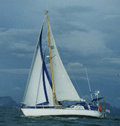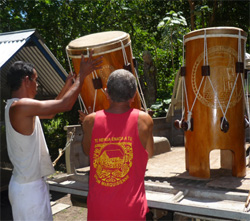Weatherly Sailing Adventures












At last under-way from Galapagos, the winds were a dream. Nice 15-25knot south-easterly to easterly winds were the norm, and Weatherly scooted along at up to 8 knots under mainsail, staysail and poled-out yankee. All yacht systems were functioning properly again, and it was enjoyable sailing.
Small flying fish skittered across the water in schools. They look funny to me, like mechanical wind-up toys, flapping their delicate wings, but careening off in random directions. Several every morning are found lying on the decks of Weatherly, but during the day I flick any live ones back into the sea when I hear them flutter around.
It surprises me how many sea birds are flying around out there in the middle of all that expanse of water. I wonder where they sleep? They don't seem to land on Weatherly to rest up, but perhaps they are interested in the flying fish which accidentally maroon themselves on the decks.
I baked a loaf of bread on the way, and turned out pretty good, with sunflower and sesame seeds added for more texture and flavour.
The Pacific ocean is huge - the largest ocean in the world, measuring 11,000 miles across at the equator, and 9,000 miles north to south.*
It covers an area of 30 million square miles, just between the tropics of Cancer and Capricorn, where the majority of pacific islands are dotted
throughout. *
(* Reference: Landfalls of Paradise, Earl Hinz and Jim Howard).
I sighted only one ship passing by, around the half-way point across. I turned the radar on often but the sea was empty of ships. This was
reassuring to me to get some decent sleep.
The passage was around 3000nautical miles, the longest hop I would make in the whole voyage. It
took 21 days to cross, at an average speed of around 6 knots.
So it is with some jubilation to sight land once more. The Marquesas are volcanic islands, with very steep and green mountains.
Fatu Hiva is my first port of call, though not an official port of entry to French Polynesia. It is lush, with deep, crinkled valleys, and the entrance to Hanahave bay is spectacular. There are tall pinnacles of rock around the bay, and a steep sided valley with a road winding down through the village to a small boats dock.
I was greeted by friends Ed and Nila, on their beautiful catamaran, Quixote. They invited me to have dinner and a celebratory drink after assisting me by radio to anchor in the dark nearby.
I saw the local Gendarme (policeman) to check in to the islands, and was given a few days before proper formalities were to be completed at the next island, Hiva Oa. I tried to get money out and a phone card, but the shops and post office were open at odd times, so took a walk up to see the waterfall.
I asked directions several times along the way, as I took a few wrong turns. An old man at the end of the valley gave final directions to the falls, and asked if I was a mechanic. He had an electrical problem with his generator, and I said I'd be happy to return later with my tools and meter to have a look.
The falls were around 60m high, and falling into a deep cool pool, quite refreshing to have a dip in after the long walk up the hill and on the rough trail. The water sprinkled down off the black rocks and fell softly into the pool like raindrops. It was a lovely, natural setting with green foliage around the rocks.
I passed the banana farm with the old man again. He was setting up a big table for a family party with his sons and girlfriends. The boys
double checked the time that I would
come back to look at their generator, and I had to walk quickly now to make the appointment.
In the village I passed three little girls sitting on the side of the road playing games. They'd given me directions to the waterfall, and now asked
for 'Stilos' (pens), but through missing front teeth it sounded to me like 'Thteelo'.
They were so cute. I promised I'd come back later with 'Thteelos'. When I returned later from the
yacht with pens, paper and some coloured hairclips etc, they'd gone.
I put on the pace to make my appointment with the old man, and was short on breath and hot again, after the half hour walk up the hill to get up there. So it was disappointing to find no-one home. The party had finished and place deserted.
After 20minutes waiting and calling out, I wandered back down to the town again. I found the boys were sitting around and asked what I was up to. 'The generator...'? I pondered, showing them the meter and tools I brought. It seemed they'd forgotten all about the idea of looking at it to get it working again, but were happy to drive me back up the mountain in their big, new 4 wheel drive, with music blaring. I wondered how they would afford such an expensive car on a small banana farm on a little island.
After unscrewing the generator's covers and cleaning out an abandoned hornets nest, I tested a few components with the meter and found the fault. A wire had corroded and disconnected. So, the boys stripped the end of the wire and screwed it in place and the generator worked again. I was happy to help some locals in problem I could solve. It was clear the father was very pleased with the result too, offering me a huge stalk of bananas, which I unsuccessfully tried to have reduced to just a hand of bananas. Also a deep-fried pastry ring and some huge pamplemousse (grapefruit).
The grapefruits in fatu Hiva were delicious - sweet and very juicy. Other locals generously offered me some later also, for no apparent reason, other being hospitable.
Ed and Nila took me for a ride in their dinghy to the next bay, which had a larger village, and a museum. It contained some carved wooden bowls, some pictures of dancers and festivals, and some warriors spears and clubs. We had to locate the museum's attendant in her house to unlock the door for us and show us in. She was also very kind and her husband arrived with 2 large drums, for the festival coming up in December. they invited us to stay and have lunch with them. It was a highlight of my visit to have lunch and talk with our charming hosts.

Finally I sailed on to Hiva Oa, to clear in properly with the gendarmes there, giving my yacht registration and passport etc.
The Marquesas are very beautiful, but to go there, yachts must pay a bond equal to the cost of a plane fare back home. That amounted to Aus $1500, which was more than I had left in my bank accounts. I hadn't realised how low my funds had reached, and was shocked to have to exchange the balance in my remaining US dollars, with hardly any money left to eat. Well my dad came to the rescue again and offered to lend me some more so I could continue on my way again.
I caught up with my friends Paul and Barb on their catamaran, Quiemarla, and we met again in the beautiful island of Tauata. It had a white sand beach, with surrounding hills and greenery, and we had some dinners together and enjoyed their company.
After changing the oil one day, I found the engine struggling to start. It refused to turn even by hand after the starter failed to crank it.
I tried again in the morning, and tried to deduce what the problem was, but guessed it was a water lock.
Quiemarla generously offered to sail their catamaran back to Hiva Oa with me, to help tow me in to the harbour. Once there I found more help from a mechanic, but he didn't have time to do any work on it. I was able to get the starter working, and even the engine running, but it overheated after an hour. I found that the water level was falling, and there was no water in the bilge, so assumed the worst, that the head gasket had broken.
All the other tests confirmed it, so I sailed on for Nuku Hiva where there was a good mechanic, who worked in the tecnical school there.
My other Aussie friends on La Barca arrived, and their daughter, Amy had her birthday party there. It was a fun afternoon, and I enjoyed catching up with Adam and Bronwyn and meeting the cruisers anchored and some who live on the island.
I got some help to take the head off the engine, and had a new gasket ordered, through my dad. I couldn't remember the right one, but by luck dad ordered and sent the exact one I needed, for the repair stage the engine was at.
I found the mechanic, Patrick, and he brought another French assistant, Freddo to help take the head off the engine. I'd removed all the peripheral stuff first, such as alternater, heat exchanger, intake and exhaust manifolds etc beforehand, so it didn't take long before the head was removed. Close inspection of the gasket revealed a small crack in the gasket around the 2nd cylinder. The assumptions were correct, and now it was just a matter of time for the part to arrive, and have the engine reassembled.
My batteries were very low after all the engine cranking, and there was not consistent wind or sun to keep them topped up. So I was happy when La barca offered their generator, and some young French guys offered a good battery charger to get my batteries restored.
Adam and Bronny met a local guy, Basil, who designs and makes Polynesian tatoos. It is part of the lifestyle there for men and women, and many had elaborate tatoos all over their bodies, necks and faces.
Basil took time to think out a combined manta-ray / turtle motif for Adam, and a spiralling flower for Bronwyn. His tatoos were real artworks and there was much in the design that Adam proudly explained to me. I liked them too, but not enough to endure pain, finances or confidence to live with one for my life. I think if ever I wanted a tatoo, a Polynesian art design would be my choice too. There are symbols and imagery cleverly formed in relief (where the skin makes shapes bordered by the ink), as much as the inked shapes themselves.








